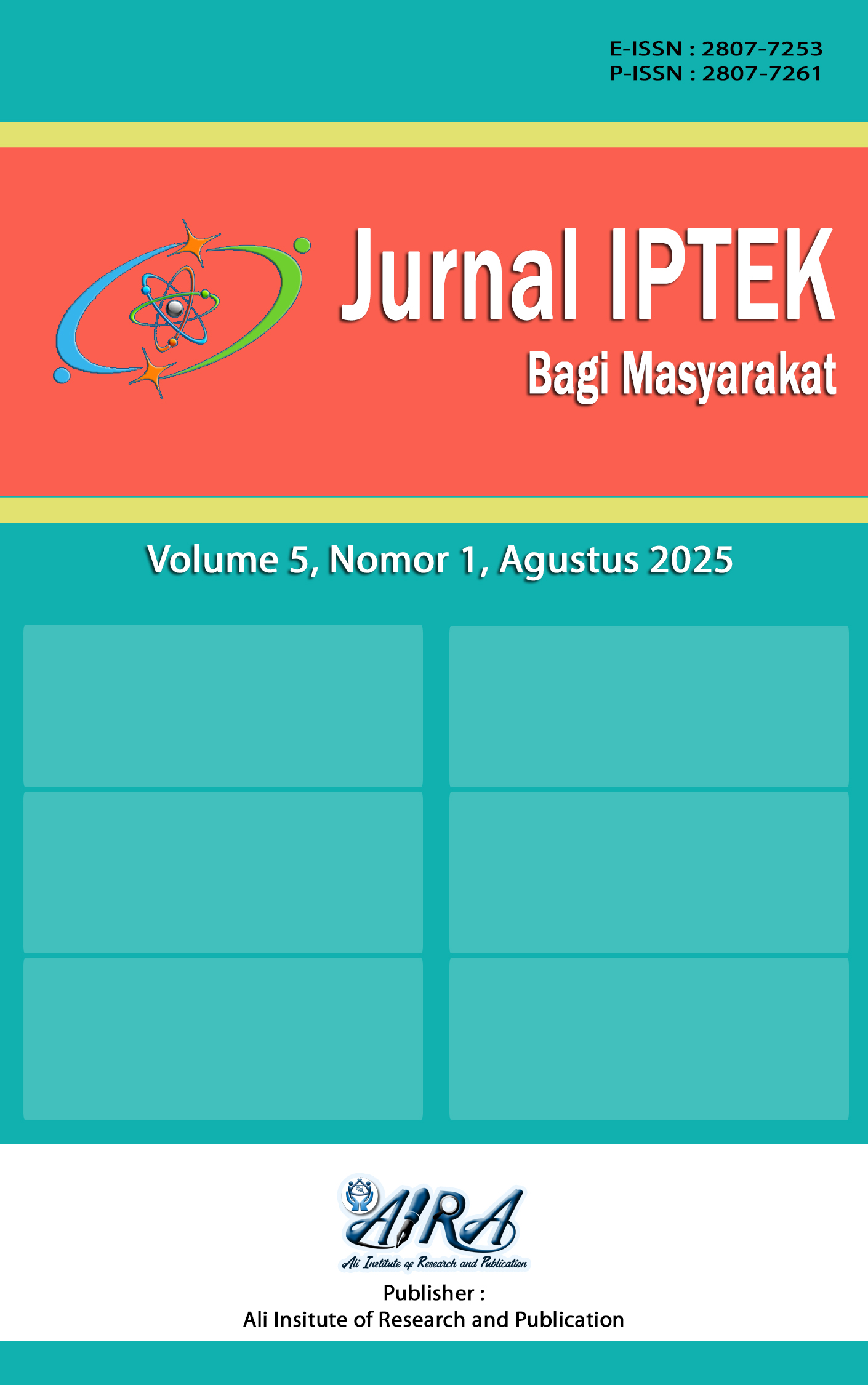Descriptive Inferential Analysis of Students' Perceptions of Online and Offline Learning and Its Relationship to Academic Achievement
DOI:
https://doi.org/10.55537/j-ibm.v5i1.1171Keywords:
online, learning effectiveness, offline, student perceptions, digital technologyAbstract
In the digital age, online and offline learning have become the primary methods at UINSU. Online learning offers flexibility but faces challenges such as internet connection issues and limited interaction, while offline learning is considered more effective because it allows for direct interaction despite limited facilities. This study aims to analyze the perceptions of students in the Information Systems Program at UINSU, class of 2023, toward both learning methods and their relationship with academic performance based on GPA. This study uses a quantitative approach with descriptive and inferential methods. Data were collected through an online questionnaire, then tested for validity and reliability, and analyzed using descriptive statistics and chi-square tests at a significance level of 0.05. The results show that students prefer face-to-face learning because it supports direct interaction, increases motivation, and facilitates understanding of the material, while online learning is considered less effective due to technical challenges and low participation rates. The chi-square test revealed a significant relationship between learning methods and GPA, with face-to-face learning contributing more significantly to academic performance. These findings suggest that a hybrid approach has the potential to be an effective solution and provides insights for program administrators in developing learning strategies that align with student needs. This analysis is important as a contribution to the development of more adaptive and relevant educational strategies, as well as a form of academic service to improve the quality of learning in higher education.
Downloads
References
Alkhoir, A. M., Nawawi, I., Nurjasir, M. M. A., & Syafari, Z. F. (2024). Dampak pembelajaran daring terhadap motivasi belajar mahasiswa Teknologi Pendidikan angkatan 2023. Realisasi: Ilmu Pendidikan, Seni Rupa dan Desain, 1(3), 41–45. https://doi.org/10.62383/realisasi.v1i3.145
Ardhaneswari, P. P. N., & Suwitra, I. W. C. (2024). Analisis korelasi Pearson dalam menentukan hubungan harga dengan volume penjualan Wardah Matte Lip Cream pada platform e-commerce Shopee. JIS SIWIRABUDA, 2(2), 151–156. https://doi.org/10.58878/jissiwirabuda.v2i2.302
Darwis, M., Nasrullah, M., & Arhas, S. H. (2022). Comparative study: The use of online and offline learning media. SHS Web of Conferences, 149, 01011. https://doi.org/10.1051/shsconf/202214901011
Forester, B. J., Khater, A. I. A., Afgani, M. W., & Isnaini, M. (2024). Penelitian kuantitatif: Uji reliabilitas. Jurnal Pendidikan dan Penelitian Ilmiah, 4(3), 101–108.
Gani, R. H. A., Ernawati, T., Supratmi, N., & Wijaya, H. (2023). Efektivitas pembelajaran daring mata kuliah MKU Bahasa Indonesia pada mahasiswa Universitas Hamzanwadi pada masa pandemi Covid-19. Jurnal Evaluasi dan Pembelajaran, 5(1), 8–19.
Hakim, M. H., Muhtadi, A., Saputra, F. F., Ahmad, H., Rasyid, M. M., Setiyono, W. P., Fadli, M., & Himawan, L. Y. (2025). Dampak pembelajaran kuliah secara daring. Jurnal Pendidikan Teknologi, 4(1), 22–34.
Herinanto, D., Utami, B. H. S., Helmita, H., & Arif, D. (2024). Analisis Chi Square zona wilayah marketing terhadap penjualan produk ekonomi kreatif. eCo-Buss, 6(3), 1626–1637. https://doi.org/10.32877/eb.v6i3.1240
Imanika, A. D., Pangastuti, D. P., & Setiaji, B. (2023). Efektivitas pembelajaran luring dan daring bagi mahasiswa Pendidikan Fisika angkatan 2023. Jurnal Pendidikan Jarak Jauh, 1(1), 15–23. https://doi.org/10.47134/jpjj.v1i1.185
Ismira, & Darmawan, R. (2024). Persepsi guru terhadap pembelajaran dalam jaringan (daring) dan luar jaringan (luring) di sekolah dasar se-Kelurahan Pasar Ambacang Kecamatan Kuranji. Jurnal Riset Pendidikan Dasar dan Karakter, 6(1), 1–10. https://doi.org/10.59701/pdk.v6i1.228
Kristiyantini, E. P. (2022). Analisis kesulitan pembelajaran daring mahasiswa Pendidikan Guru Sekolah Dasar Universitas Muhammadiyah Surakarta. Jurnal Bidang Pendidikan Dasar, 6(1), 1–9. https://doi.org/10.21067/jbpd.v6i1.6102
Krisnawati, E., Artanti, K. D., & Umar, N. H. (2024). Uji validitas dan reliabilitas instrumen penelitian dukungan suami terhadap hambatan penggunaan metode kontrasepsi jangka panjang pada multipara akseptor aktif di Surabaya. Media Gizi Kesmas, 13(2), 659–664. https://doi.org/10.20473/mgk.v13i2.2024.659-664
Muqarrobi, M. F., Bahri, S. P., Juniar, A. D., & Salsabila, A. (2024). Pengaruh efektivitas pembelajaran luring dan pembelajaran daring terhadap pencapaian IPK mahasiswa Pendidikan Bisnis 2023. Jurnal Inovasi Pendidikan, 7(12), 33–41.
Mustafa, P. S. (2022). Pengaruh metode pembelajaran berbasis proyek terhadap hasil belajar siswa SMK. Didaktika: Jurnal Pemikiran Pendidikan, 28(2[1]), 71–80. https://doi.org/10.30587/didaktika.v28i2(1).4166
Prayogi, A., & Kurniawan, M. A. (2024). Pendekatan kualitatif dan kuantitatif: Suatu telaah. Jurnal Studi Metodologi Pendidikan, 1(1), 12–20.
Subhaktiyasa, P. G., Candrawati, S. A. K., Sumaryani, N. P., Sunita, N. W., & Syakur, A. (2025). Penerapan statistik deskriptif: Perspektif kuantitatif dan kualitatif. Emasains: Jurnal Edukasi Matematika dan Sains, 14(1), 96–104. https://doi.org/10.59672/emasains.v14i1.4450
Sanaky, M. M., Saleh, L. M., & Titaley, H. D. (2021). Analisis faktor-faktor penyebab keterlambatan pada proyek pembangunan gedung asrama MAN 1 Tulehu Maluku Tengah. Jurnal Manajemen Konstruksi, 11(1), 45–53.
Setiawan, A. P., Masruri, L., & Trastianingrum, S. A. P. (2021). Efek metode pembelajaran daring (pembelajaran jarak jauh) akibat COVID-19: Perspektif pelajar dan mahasiswa. Jurnal Pendidikan Terbuka, 16(1), 1–10.
Setiaji, B., Mufida, F., & Puspitasari, A. (2023). Perbandingan efektivitas pembelajaran fisika daring dan pembelajaran fisika luring. Jurnal Pendidikan Jarak Jauh, 1(2), 10–18. https://doi.org/10.47134/jpjj.v1i2.203
Romdona, S., Junista, S. S., & Gunawan, A. (2025). Teknik pengumpulan data: Observasi, wawancara, dan kuesioner. JISOSEPOL: Jurnal Ilmu Sosial Ekonomi dan Politik, 3(1), 39–47. https://doi.org/10.61787/taceee75
Sari, S. I. (2021). Efektivitas pembelajaran daring dan luring di SMP Negeri 3 Pleret. Alinea: Jurnal Bahasa, Sastra, dan Pengajaran, 10(2), 145–154. https://doi.org/10.35194/alinea.v10i2.1079
Thelma, C. C., & Phiri, E. V. (2024). The efficacy and acceptance of online learning vs. offline learning in higher learning institutions: A systematic review. Zenodo. https://doi.org/10.5281/zenodo.13299777
Downloads
Published
How to Cite
Issue
Section
License
Copyright (c) 2025 Nurul Zafirah, Defiyana Lubis, Dimas Afandi, Adelyna Oktavia Nasution

This work is licensed under a Creative Commons Attribution-NonCommercial-ShareAlike 4.0 International License.




